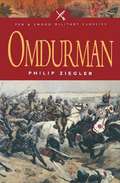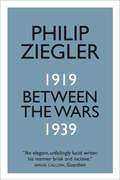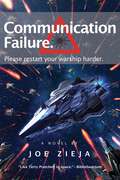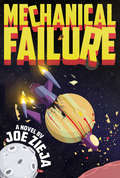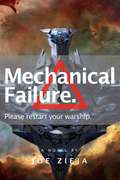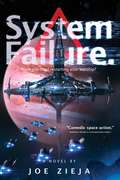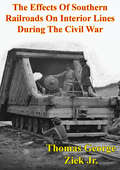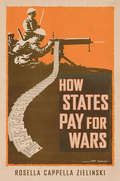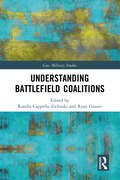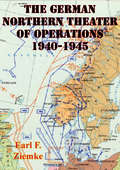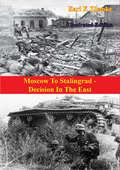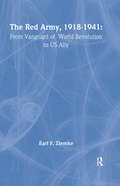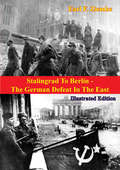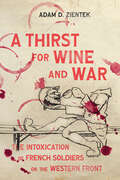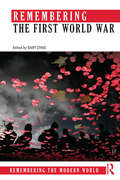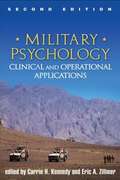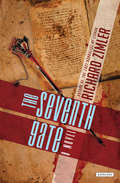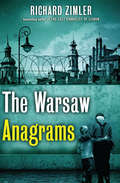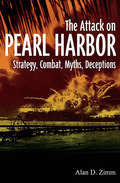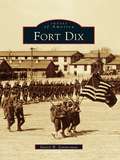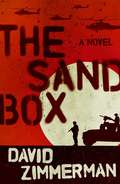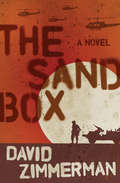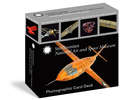- Table View
- List View
Omdurman (Pen & Sword Military Classics)
by Peter ZieglerA you-are-there account of the 19th-century battle against the army of Abdullah al-Taashi that established British dominance in the Sudan. The death of General Gordon in Khartoum at the hand of the Dervishes is one of the most celebrated events in the history of the 19th century. Equally dramatic, but perhaps less well-known, is the extraordinary battle 14 years later in which Sir Herbert Kitchener avenged the murder of Gordon at Omdurman. Personal accounts of the legendary battle seen through the eyes of Private George Teigh and Lieutenant Samuel FitzGibbon Cox are included. Both the private and the officer kept diaries, both recorded the same events, but with vastly differing views. Difficulties with boots, bullets and gunboats are described, but it is the eye-witness accounts that give full flavor to a fascinating campaign, which saw the last full cavalry charge.
Between the Wars: 1919-1939
by Philip ZieglerAt the end of 1918 one prescient American historian began to write a history of the Great War. "What will you call it?" he was asked. "The First World War" was his bleak response. In Between the Wars Philip Ziegler examines the major international turning points - cultural and social as well as political and military - that led the world from one war to another. His perspective is panoramic, touching on all parts of the world where history was being made, giving equal weight to Gandhi's March to the Sea and the Japanese invasion of China as to Hitler's rise to power. It is the tragic story of a world determined that the horrors of the First World War would never be repeated yet committed to a path which in hindsight was inevitably destined to end in a second, even more devastating conflict.
London at War, 1939-1945
by Philip ZieglerIn 1939, London was not merely the greatest city in the world, it was the most tempting and vulnerable target for aerial attack. For six years it was in the front line of the free world’s battle against Fascism. It endured the horrors of the blitz of 1940 and 1941, the V1s, the V2s. Other cities suffered more intensely; no other city was so consistently under attack for so long a time. This is the story of London at war from 1939 to 1945, or perhaps of Londoners at war--for Philip Ziegler, best known as a biographer, is above all fascinated by the people who found their lives so suddenly and violently transformed: the querulous, tiresome, yet strangely gallant housewife from West Hampstead; the turbulent, left-wing, retired schoolmaster from Walthamstow, always standing up to the authorities; the odiously snobbish middle-class woman from Kensington, sneering at the 'scum' who took shelter in the Underground; the typist from Fulham; the plumber from Woolwich. It was their war every bit as much as it was Churchill’s or the King’s, and this is their story. Through a wealth of interviews and unpublished letters and diaries, as well as innumerable books and newspapers, the author has built up a dazzling portrait of an entire population under siege. There were cowards, there were criminals, there were incompetents, but what emerges from these pages is above all a record, in story after story, of astonishing patience, dignity and humour. 'I hope,' Ziegler writes, 'we will never have to endure again what they went through between 1939 and 1945. I hope, if we did, that we would conduct ourselves as well.'
Communication Failure (Epic Failure Trilogy #2)
by Joe ZiejaIn this sequel to Mechanical Failure, Captain Rogers, despite his best attempts to do otherwise, has become the acting admiral of the 331st Meridan fleet. His first task: worrying. A lot.The rival Thelicosan fleet, under the influence of bad intelligence, a forbidden romance, and a communication officer with an eardrum injury, is about to break a two-hundred-year-old nonaggression pact. They have offered a vague, easily misinterpreted message: &“We&’re invading.&” Rogers isn&’t sure, but he thinks that&’s probably bad. War is hell, especially when you&’ve forgotten how to fight one.
Mechanical Failure (Epic Failure #1)
by Joe ZiejaThe Two Hundred Years (And Counting) Peace Treaty led to inept military bureaucracy, and no one is more perfectly suited to take advantage of it than R. Wilson Rogers (don't ask what the 'R' stands for). After drinking, gambling, and swindling his way through the military, he's ready for something bigger: professional space pirate.But pirating is risky, namely it's illegal, even in space. And when Rogers is arrested attempting to pull off his biggest con yet, his sentence is re-enlistment. More drinking, grilling, and poker? Rogers couldn't agree fast enough.However, the military he left is not the military he finds upon boarding the MPS FLAGSHIP. A conspiracy is afoot, with soldiers doing actual soldier things and AI-droids handling sensitive intelligence. Rogers is the only one who questions the droids' information, but the bureaucracy doesn't care. Which means his worst nightmare: he might have to do actual work to prevent a war.
Mechanical Failure (Epic Failure Trilogy #1)
by Joe ZiejaA smooth-talking ex-sergeant, accustomed to an easygoing peacetime military, unexpectedly rejoins the fleet and finds soldiers preparing for the strangest thing—war.The two hundred years’ (and counting) peace is a time of tranquility that hasn’t been seen since...well, never. Mankind in the Galactic Age had finally conquered war, so what was left for the military to do but drink and barbecue? That’s the kind of military that Sergeant R. Wilson Rogers lived in before he left the fleet to become a smuggler. But it turns out that smuggling is hard. Like getting-arrested-for-dealing-with-pirates-and-forced-back-into-service kind of hard. It doesn’t seem so bad—the military was a perpetual tiki party anyway—but when Rogers returns after only a year away, something has changed. These are soldiers—actual soldiers doing actual soldier things like preparing for a war that Rogers is sure doesn’t exist. Rogers vows to put a stop to all this nonsense—even if it means doing actual work. With an experienced ear for military double-speak, Zieja has created a remarkable and sarcastic adventure.
System Failure (Epic Failure Trilogy #3)
by Joe ZiejaWar is spreading through the galaxy—and it’s becoming abundantly clear that there’s an outside force at play in this explosive and hilarious new installment of the Epic Failure series that reads like Catch-22 meets David Weber. With the galaxy thrown into chaos by mutual breaches of the Two Hundred Years’ peace, what seemed like an isolated incident on the Thelicosa/Merida border has become an epidemic. In the midst of this chaos, the Thelicosan and Meridan fleets on their respective borders have come to a sort of tense peace after the events in Book II but now it’s clear: somebody wants war. And it’s not the Free Systems of the galaxy. No. It’s a mom-and-pop convenience store gone galactic. It’s the purveyors of balloons and nachos and supplies for bowling lanes. It’s the company that made the droids and a large part of the technology that all of the Free Systems are using in their militaries. It’s Snaggardirs. And they want to snag it all.
The Effects Of Southern Railroads On Interior Lines During The Civil War
by Thomas George Ziek Jr.The purpose of this paper is to study the effects of the Southern railroad system on interior lines during the Civil War and determine whether or not the South enjoyed the advantage of interior lines. The use of railroads during this conflict placed an enormous physical strain upon the limited industrial resources of the Confederacy, and a great strain upon the intellectual agility of the Confederate High Command. Based upon the evidence studied, and the time-space comparisons of both Northern and Southern railway operations, several conclusions can be drawn: the South entered the war with a rail system that was unable to meet the demands of modern war; the Confederate leadership understood the importance of the railroad and its importance to strategic operations early in the war, but were unwilling to adopt a course of action that best utilized their scarce assets; Southern railroad speeds decreased dramatically by 1863 due to the inability of Southern railroads owners to perform needed maintenance on their railroad equipment; tactical reverses on the field of battle, especially the losses of both Corinth in May of 1862 and Knoxville in September of 1863 increased the distances that re-enforcements would have to travel to fight a mobile intra-theater war; Union control, maintenance, and organization of its railway assets ensured that it would be able to move large numbers of troops at the strategic level efficiently from early 1863 to the end of the war. Based on these conclusions, the Confederacy lost the ability to shift troops on the strategic level more rapidly than the Union by 1863. This was a result of its physically weakened railroad system and military setbacks which caused Southern railroads to move forces over longer distances.
How States Pay for Wars
by Rosella Capella ZielinskiArmies fight battles, states fight wars. To focus solely on armies is to neglect the broader story of victory and defeat. Military power stems from an economic base, and without wealth, soldiers cannot be paid, weapons cannot be procured, and food cannot be bought. War finance is among the most consequential decisions any state makes: how a state finances a war affects not only its success on the battlefield but also its economic stability and its leadership tenure. In How States Pay for Wars, Rosella Cappella Zielinski clarifies several critical dynamics lying at the nexus of financial and military policy.Cappella Zielinski has built a custom database on war funding over the past two centuries, and she combines those data with qualitative analyses of Truman's financing of the Korean War, Johnson’s financing of the Vietnam War, British financing of World War II and the Crimean War, and Russian and Japanese financing of the Russo-Japanese War. She argues that leaders who attempt to maximize their power at home, and state power abroad, are in a constant balancing act as they try to win wars while remaining in office. As a result of political risks, they prefer war finance policies that meet the needs of the war effort within the constraints of the capacity of the state.
Understanding Battlefield Coalitions (Cass Military Studies)
by Rosella Cappella Zielinski Ryan GrauerThis book improves our understanding of battlefield coalitions, providing novel theoretical and empirical insight into their nature and capabilities, as well as the military and political consequences of their combat operations. The volume provides the first dataset of battlefield coalitions, uses primary sources to understand how non-state actors of varying types form such groupings, reports interviews with policymakers illuminating North Atlantic Treaty Organization operations, and uses cases studies of various wars waged throughout the nineteenth, twentieth, and twenty-first centuries to understand how other such collectives have operated. Part I introduces battlefield coalitions as an object of study, demonstrating how they are distinct from other wartime collectives. Using a novel dataset of actors fighting in 492 battles during interstate wars waged between 1900 and 2003, it provides, for the first time, a comprehensive portrait of the universe of battlefield coalitions. Part II explores processes and dynamics involved in the formation of battlefield coalitions, addressing how potential coalition members prepare for future battles in peacetime (as well as the consequences of such preparations) and the dynamics of mission design. Part III focuses on how battlefield coalitions are organised and fight when combat ensues, notably their decision-making rules and practices, command structures, and learning capacities. Part IV addresses three curious tendencies observed in the operations of battlefield coalitions: partners under-providing effort in combat, rebels and terrorist networks persisting in cooperation even when their interests diverge, and members defecting from the collective. Part V concludes with a chapter outlining for future researchers what we know about battlefield coalitions and what remains to be understood. This book will be of much interest to students of military and strategic studies, defence studies and International Relations.
Contested Commemorations
by Benjamin ZiemannThis innovative study of remembrance in Weimar Germany analyses how experiences and memories of the Great War were transformed along political lines after 1918. Examining the symbolism, language and performative power of public commemoration, Benjamin Ziemann reveals how individual recollections fed into the public narrative of the experience of war. Challenging conventional wisdom that nationalist narratives dominated commemoration, this book demonstrates that Social Democrat war veterans participated in the commemoration of the war at all levels: supporting the 'no more war' movement, mourning the fallen at war memorials and demanding a politics of international solidarity. It describes how the moderate Socialist Left related the legitimacy of the Republic to their experiences in the Imperial army and acknowledged the military defeat of 1918 as a moment of liberation. This is the first comprehensive analysis of war remembrances in post-war Germany and a radical reassessment of the democratic potential of the Weimar Republic.
German Northern Theater of Operations 1940-1945 [Illustrated Edition]
by Earl Ziemke[Includes 23 maps and 31 illustrations]This volume describes two campaigns that the Germans conducted in their Northern Theater of Operations. The first they launched, on 9 April 1940, against Denmark and Norway. The second they conducted out of Finland in partnership with the Finns against the Soviet Union. The latter campaign began on 22 June 1941 and ended in the winter of 1944-45 after the Finnish Government had sued for peace.The scene of these campaigns by the end of 1941 stretched from the North Sea to the Arctic Ocean and from Bergen on the west coast of Norway, to Petrozavodsk, the former capital of the Karelo-Finnish Soviet Socialist Republic. It faced east into the Soviet Union on a 700-mile-long front, and west on a 1,300-mile sea frontier. Hitler regarded this theater as the keystone of his empire, and, after 1941, maintained in it two armies totaling over a half million men.In spite of its vast area and the effort and worry which Hitler lavished on it, the Northern Theater throughout most of the war constituted something of a military backwater. The major operations which took place in the theater were overshadowed by events on other fronts, and public attention focused on the theaters in which the strategically decisive operations were expected to take place. Remoteness, German security measures, and the Russians' well-known penchant for secrecy combined to keep information concerning the Northern Theater down to a mere trickle, much of that inaccurate. Since the war, through official and private publications, a great deal more has become known. The present volume is based in the main on the greatest remaining source of unexploited information, the captured German military and naval records. In addition a number of the participants on the German side have very generously contributed from their personal knowledge and experience.
Moscow To Stalingrad - Decision In The East [Illustrated Edition] (The Russian Campaign of World War Two #1)
by Earl F. ZiemkeContains 92 illustrations and 45 maps of the Russian Campaign.A brilliant modern history of the German invasion of Russia to their bloody crushing defeat by the re-invigorated Russian forces at the siege of Stalingrad.During 1942, the Axis advance reached its high tide on all fronts and began to ebb. Nowhere was this more true than on the Eastern Front in the Soviet Union. After receiving a disastrous setback on the approaches to Moscow in the winter of 1941-1942, the German armies recovered sufficiently to embark on a sweeping summer offensive that carried them to the Volga River at Stalingrad and deep into the Caucasus Mountains. The Soviet armies suffered severe defeats in the spring and summer of 1942 but recovered to stop the German advances in October and encircle and begin the destruction of the German Sixth Army at Stalingrad in November and December. This volume describes the course of events from the Soviet December 1941 counteroffensive at Moscow to the Stalingrad offensive in late 1942 with particular attention to the interval from January through October 1942, which has been regarded as a hiatus between the two major battles but which in actuality constituted the period in which the German fortunes slid into irreversible decline and the Soviet forces acquired the means and capabilities that eventually brought them victory. These were the months of decision in the East.
The Red Army, 1918-1941: From Vanguard of World Revolution to America's Ally
by Earl F ZiemkeSupported in large part by evidence released after the collapse of the Soviet Union, this book follows the career of the Red Army from its birth in 1918 as the designated vanguard of world revolution to its affiliation in 1941 with 'the citadel of capitalism', the United States. Effectiveness of leadership and military doctrine are particular conce
Stalingrad To Berlin - The German Defeat In The East [Illustrated Edition] (The Russian Campaign of World War Two #2)
by Earl F. ZiemkeContains 72 illustrations and 42 maps of the Russian Campaign.After the disasters of the Stalingrad Campaign in the Russian winters of 1942-3, the German Wehrmacht was on the defensive under increasing Soviet pressure; this volume sets out to show how did the Russians manage to push the formerly all-conquering German soldiers back from Russian soil to the ruins of Berlin.Save for the introduction of nuclear weapons, the Soviet victory over Germany was the most fateful development of World War II. Both wrought changes and raised problems that have constantly preoccupied the world in the more than twenty years since the war ended. The purpose of this volume is to investigate one aspect of the Soviet victory-how the war was won on the battlefield. The author sought, in following the march of the Soviet and German armies from Stalingrad to Berlin, to depict the war as it was and to describe the manner in which the Soviet Union emerged as the predominant military power in Europe.
A Thirst for Wine and War: The Intoxication of French Soldiers on the Western Front (Intoxicating Histories)
by Adam D. ZientekBeginning in the fall of 1914, every French soldier on the Western Front received a daily ration of wine from the army. At first it was a modest quarter litre, but by 1917 it had increased to the equivalent of a full bottle each day. The wine ration was intended to sustain morale in the trenches, making the men more willing to endure suffering and boredom. The army also supplied soldiers with doses of distilled alcohol just before attacks to increase their ferocity and fearlessness. This strategic distribution of alcohol was a defining feature of French soldiers’ experiences of the war and amounted to an experimental policy of intoxicating soldiers for military ends.A Thirst for Wine and War explores the French army’s emotional and behavioural conditioning of soldiers through the distribution of a mind-altering drug that was later hailed as one of the army’s “fathers of victory.” The daily wine ration arose from an unexpected set of factors including the demoralization of trench warfare, the wine industry’s fear of losing its main consumers, and medical consensus about the benefits of wine drinking. The army’s related practice of distributing distilled alcohol to embolden soldiers was a double-edged sword, as the men might become unruly. The army implemented regulations and surveillance networks to curb men’s drinking behind the lines, in an attempt to ensure they only drank when it was useful to the war effort. When morale collapsed in spring 1917, the army lost control of this precarious system as drunken soldiers mutinied in the thousands. Discipline was restored only when the army regained command of soldiers’ alcohol consumption.Drawing on a range of archives, personal narratives, and trench journals, A Thirst for Wine and War shows how the French army’s intoxication of its soldiers constituted a unique exercise of biopower deployed on a mass scale.
Remembering the First World War (Remembering the Modern World)
by Bart ZiinoRemembering the First World War brings together a group of international scholars to understand how and why the past quarter of a century has witnessed such an extraordinary increase in global popular and academic interest in the First World War, both as an event and in the ways it is remembered. The book discusses this phenomenon across three key areas. The first section looks at family history, genealogy and the First World War, seeking to understand the power of family history in shaping and reshaping remembrance of the War at the smallest levels, as well as popular media and the continuing role of the state and its agencies. The second part discusses practices of remembering and the more public forms of representation and negotiation through film, literature, museums, monuments and heritage sites, focusing on agency in representing and remembering war. The third section covers the return of the War and the increasing determination among individuals to acknowledge and participate in public rituals of remembrance with their own contemporary politics. What, for instance, does it mean to wear a poppy on armistice/remembrance day? How do symbols like this operate today? These chapters will investigate these aspects through a series of case studies. Placing remembrance of the First World War in its longer historical and broader transnational context and including illustrations and an afterword by Professor David Reynolds, this is the ideal book for all those interested in the history of the Great War and its aftermath.
Military Psychology, Second Edition
by Eric A. Zillmer Carrie KennedyWidely regarded as the authoritative reference in the field, this book comprehensively explores the psychological needs of today's service members and how to meet them effectively. Expert contributors review best practices for conducting fitness-for-duty evaluations and other types of assessments, treating frequently encountered clinical problems, responding to disasters, and promoting the health and well-being of all personnel. The book also examines the role of mental health professionals in enhancing operational readiness, with chapters on crisis and hostage negotiation, understanding terrorists, and more. New to This Edition The latest scientific knowledge, clinical interventions, and training recommendations. Chapter on acute combat stress. Chapter on post-deployment problems, including PTSD and depression. Chapter on military psychology ethics. Coverage of blast concussion screening and evaluation.
The Seventh Gate: A Novel
by Richard ZimlerA girl on the brink of adulthood. A city on the brink of war. “An intelligent and moving novel about the heartbreaking human condition” (Alberto Manguel, author of The Library at Night). It’s Berlin, 1932. Sophie is a smart and sexually precocious fourteen-year-old coming of age during Hitler’s rise to power. Forced to lead a double life when her father and her boyfriend become Nazi collaborators, she reserves her dreams of becoming an actress for her beloved elderly neighbor, Isaac Zarco, and his friends, most of whom are Jews working against the government in a secret group called the Ring. When a member is sent to Dachau, she realizes there must be a Nazi traitor in the group . . . Through successive mysteries, reversals, and surprises—and a race against time—The Seventh Gate builds to a shattering end. In its chilling but sensuous evocation of the time and place, Richard Zimler’s novel is a love story and a tale of ferocious heroism. “A moody, tightly constructed historical thriller that is both entertaining and instructive.” —The New York Times “Explosive and prophetic.” —Newsday “Mixing profound reflections on Jewish mysticism with scenes of elemental yet always tender sensuality, Zimler captures the Nazi era in the most human of terms, devoid of sentimentality but throbbing with life lived passionately in the midst of horror.” —Booklist (starred review) “Zimler excellently captures the gamut of tumultuous emotions in his intense and detailed portrait of a city destined for war, and his exceptionally drawn characters struggling to survive in a world gone mad make for an unforgettable story.” —Library Journal (starred review)
The Warsaw Anagrams: A Novel (Bride Series)
by Richard ZimlerThe bestselling author of The Last Kabbalist of Lisbon delivers a wartime thriller that’s “equal parts riveting, heartbreaking, inspiring, and intelligent” (San Francisco Chronicle). With his international-bestseller The Last Kabbalist of Lisbon, Richard Zimler made a name as a master of historical thrillers. In this chilling mystery, winner of the Marques de Ouro Prize, Zimler has woven a gripping tale in the tradition of The Shadow of the Wind. It is autumn, 1940, and the Nazis have sealed four-hundred-thousand Jews into the Warsaw Ghetto. Erik Cohen, an elderly psychiatrist, moves into a tiny apartment with his last remaining relatives. Then his beloved great-nephew Adam goes missing and his body is discovered tangled in the barbed wire, strangely mutilated. Soon afterward, another body turns up, this time a young girl. Could there be a Jewish traitor luring children to their deaths? With an unlikely hero and hair-raising suspense, The Warsaw Anagrams is a profoundly moving and darkly atmospheric thriller. “Part murder mystery and part historical fiction . . . Thrilling.” —The Boston Globe “A gripping, heartbreaking and beautiful thriller.” —Simon Sebag Montefiore, New York Times–bestselling author of The Romanovs “Spare but striking prose . . . Masterful.” —Newsday “A fast-moving, powerful and intellectual murder mystery set within wartime Warsaw Poland during World War II . . . Zimler provides layer after layer of intrigue and excitement. This is not simply a novel about the Holocaust. It is a murder mystery that will challenge the reader to uncover a frightening truth within a world turned upside down by war and genocide.” —New York Journal of Books
The Attack on Pearl Harbor: Strategy, Combat, Myths, Deceptions
by Alan D. Zimm<p>“Uses modern methods of operational analysis to determine exactly how the Japanese planned and executed the great raid . . . a worthy, useful analysis” (Naval History).<p> <p>The December 7, 1941 attack on Pearl Harbor has been portrayed by historians as a dazzling success. With most American historians concentrating on command errors and the story of participants’ experiences, the Japanese attack has never been subjected to a comprehensive critical analysis of the military side of the operation.<p> <p>This book presents a detailed evaluation of the attack on the operational and tactical level. It examines such questions as: Was the strategy underlying the attack sound? Were there flaws in planning or execution? How did Japanese military culture influence the planning? How risky was the attack? What did the Japanese expect to achieve, compared to what they did achieve? Were there Japanese blunders? What were their consequences? What might have been the results if the attack had not benefited from the mistakes of the American commanders?<p> <p>The book also addresses the body of folklore about the attack, assessing contentious issues such as the skill level of the Japanese aircrew; whether mini submarines torpedoed Oklahoma and Arizona, as has been recently claimed; whether the Japanese ever really considered launching a third-wave attack—and the consequences for the Naval Shipyard and the fuel storage tanks if it had been executed. In addition, the analysis has detected for the first time deceptions that a prominent Japanese participant in the attack placed into the historical record, most likely to conceal his blunders and enhance his reputation.<p>
Fort Dix (Images of America)
by Daniel W. ZimmermanLocated in central New Jersey, Fort Dix has been training soldiers since its founding in 1917. More than three million men and women have passed through its gates since it was built as one of the original sixteen army camps to train and mobilize soldiers for World War I. Using historical images, Fort Dix chronicles the history of life in an army camp from 1917 to the present. The fort, once known as Camp Dix, has experienced many changes over the years. This unprecedented photographic history traces the evolution from a wooden cantonment to the installation of brick and fiber optics, from a horse-dominated transportation system to a motor vehicle system, and from training recruits to serving Army Reserve and National Guard soldiers. Along the way, Fort Dix depicts the influence of the 78th Division, the Civilian Conservation Corps, the Women's Army Corps, Desert Storm, and the humanitarian work of resettling the Kosovo refugees.
The Sandbox
by David ZimmermanOperating Base Cornucopia. A three-hundred-year-old fortress in the remote Iraqi desert where a few dozen soldiers wait for their next assignment, among them Private Toby Durrant, a self-described "broke nobody." Then a deadly ambush touches off events that put Durrant in the middle of a far-reaching conspiracy. Insurgents massing in the nearby hills, a secretive member of military intelligence, an abandoned toy factory and a mysterious, half-feral child--Durrant must figure out the links between them if he's to survive. This blistering look at military life in "the sandbox" of Iraq marks the debut of a major new talent.
The Sandbox: A Novel
by David ZimmermanThis “gripping” and suspenseful novel of the Iraq War “will keep you turning the pages” (The New York Times). Operating Base Cornucopia is a three-hundred-year-old fortress in the remote Iraqi desert where a few dozen soldiers wait for their next assignment, among them Pvt. Toby Durrant, a self-described “broke nobody.” Then a deadly ambush touches off events that put Durrant in the middle of a far-reaching conspiracy. Insurgents massing in the nearby hills, a secretive member of military intelligence, an abandoned toy factory, and a mysterious, half-feral child—Durrant must figure out the links between them if he’s to survive. This blistering look at military life in “the sandbox” of Iraq is both a compelling mystery and a vivid evocation of an “isolated moonscape—a place as liable to produce hallucinations and heat exhaustion as it is to churn up sandstorms that last for days” (Los Angeles Times).
Smithsonian National Air and Space Museum Photographic Card Deck: 100 Treasures from the World's Largest Collection of Air and Spacecraft
by Dwight Jon ZimmermanCreated in partnership with the world-renowned Smithsonian National Air and Space Museum, this beautifully packaged, informative card deck captures, in words and stunning photographs, 100 of the museum's most important artifacts. The NASM is the world's largest, most-visited collection of historical aircraft and spacecraft, and commemorate major milestones in flight and space exploration. The 100 treasures in this deck, hand-selected by the curators, include the Spirit of St. Louis, flown by Charles Lindbergh on the first non-stop transatlantic flight; Chuck Yeager's Bell X-1, in which he broke the sound barrier; Buzz Aldrin's space suit, worn during the Apollo 11 mission, and the Space Shuttle Discovery, which flew 39 missions and spent 365 days in space. Each card includes a photograph of the object on the front and a 200-word description plus key data on the back.
